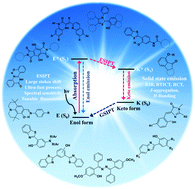Excited-state intramolecular proton-transfer (ESIPT)-inspired solid state emitters
Abstract
Solid state emitters based on excited state intramolecular proton transfer (ESIPT) have been attracting considerable interest since the past few years in the field of optoelectronic devices because of their desirable unique photophysical properties. The photophysical properties of the solid state ESIPT fluorophores determine their possible applicability in functional materials. Less fluorescence quantum efficiencies and short fluorescence lifetime in the solid state are the shortcomings of the existing ESIPT solid state emitters. Designing of ESIPT chromophores with high fluorescence quantum efficiencies and a long fluorescence lifetime in the solid state is a challenging issue because of the unclear mechanism of the solid state emitters in the excited state. Reported design strategies, detailed photophysical properties, and their applications will help in assisting researchers to overcome existing challenges in designing novel solid state ESIPT fluorophores for promising applications. This review highlights recently developed solid state ESIPT emitters with focus on molecular design strategies and their photophysical properties, reported in the last five years.



 Please wait while we load your content...
Please wait while we load your content...